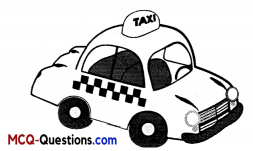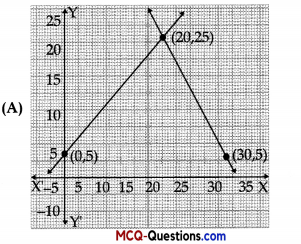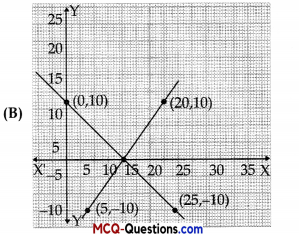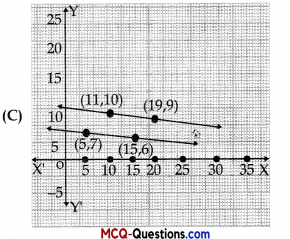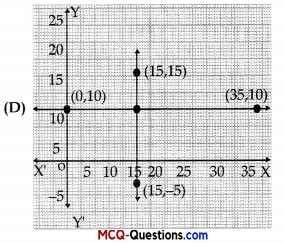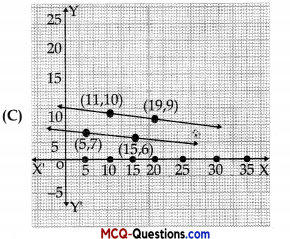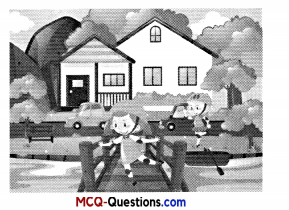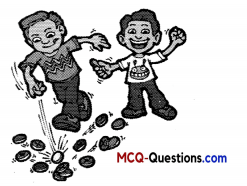MCQ Questions for Class 10 Maths Chapter 4 Quadratic Equations
Quadratic Equations Class 10 MCQ Questions with Answers
Question 1.
Which of the following is a quadratic equation ?
(A) x2 + 2x + 1 = (4 – x)2 + 3
(B) -2x2 = (5 – x) \(\left(2 x-\frac{2}{5}\right)\)
(C) (k + 1)x2 +\(\frac{3}{2}\)x = 7, where = -1
(D) x3 — x2 — (x – 1)3
Answer:
(D) x3 — x2 — (x – 1)3
Explanation:
x3 – x2 = x3 -1 – 3x(x -1)
x3 – x2 = x3 -1 – 3x2+ 3x -x2+ 3x2 +1 – 3x = 0
2x2 – 3x +1 = 0
It is of the form of ax2 +bx +c=0.
![]()
Question 2.
Which of the following is not a quadratic equation?
(A) 2(x – 1)2 = 4x2 – 2x + 1
(B) 2x – x2= x2 + 5
(C) (√2x + √3)2 + x2 = 3x2 — 5x
(D) (x2 + 2x)2 = x4+ 3 + 4x3
Answer:
(C) (√2x + √3)2 + x2 = 3x2 — 5x
Explanation:
(√2x)2 + (√3)2 + 2 x √2x x √3 + x2 = 3x2-5x
2x2 3 + 2√6x + x2 = 3x2 – 5x
3x2 + 2√6x + 3 = 3x2 – 5x
x(5 + 2√6) + 3 = 0
It is not of the form of ax2 +bx +c = 0.
Question 3.
Which of the following equations has 2 as a root ?
(A) x2 – 4x + 5 = 0
(B) x2 + 3x-12 = 0
(C) 2x2-7x + 6 = 0
(D) 3x2-6x-2 = 0 0
Answer:
(C) 2x2-7x + 6 = 0
Explanation:
Put the value of x = 2 in 3x(C) 2x2-6x – 2 = 0
3(2)2 – 6(2) – 2 = 0
12 – 12 – 2 =0
12 – 14 =0
-2 ≠ 0
So, x = 2 is not a root of 3x2 – 6x – 2 = 0
Question 4
If \(\frac{1}{2}\) is a root of the equation x2 + kx – \(\frac{5}{4}\) = 0 then,the value of k is
(A) 2
(B) -2
(C) \(\frac{1}{2}\)
(D) \(\frac{1}{2}\)
Answer:
(A) 2
Explanation:
Since,\(\frac{1}{2}\) is a root of the equation
x2 + kx—\(\frac{5}{4}\) = 0
Then, \(\left(\frac{1}{2}\right)^{2}\) + k \(\left(\frac{1}{2}\right)\) – \(\frac{5}{4}\) = 0
\(\frac{1}{4}\) + \(\frac{k}{2}\) – \(\frac{5}{4}\) = 0
\(\frac{k}{2}\) = \(\frac{5}{4}\) – \(\frac{1}{4}\)
\(\frac{k}{2}\) = 1
k = 1
Question 5.
Which of the following equations has the sum of its roots as 3 ?
(A) 2x2-3x + 6 = 0
(B) —x2 + 3x-3 = 0
(C) √2x2–\(\frac{3}{\sqrt{2}}\) = x + 1 = 0
(D) 3x2 – 3x + 3 = 0
Answer:
(B) —x2 + 3x-3 = 0
Explanation:
-x2 – + 3x – 3 = 0
On comparing with ax2 +bx +c = 0
a = -1, b= 3, c = – 3 -b -3
∴Sum of the roots = \(\frac{-b}{a}\) = \(\frac{-3}{-1}\) = 3
![]()
Question 6.
The rooks of the equation x22 + 7x + 10 = 0 are:
(A) -5, -2
(B) 5, 2
(C) 5, -2
(D) -5, 2
Answer:
(A) -5, -2
Explanation:
Gwen, .x2 + 7x + 10
On Comparing with ax2 + bx + c = 0 we get a = 1, b = 7 and c = 10
⇒ x = \(\frac{-b \pm \sqrt{b^{2}-4 a c}}{2 a}\) – \(-\frac{1}{2}\)
⇒ x = \(\frac{-7 \pm \sqrt{(7)^{2}-4 \times 1 \times 10}}{2 \times 1}\)
⇒ x = \(\frac{-7 \pm \sqrt{9}}{2}\)
⇒ x= \(\frac{-7 \pm 3}{2}\)
⇒ x = \(\frac{-7+3}{2}\) or \(\frac{-7-3}{2}\)
=> x= – 2 or -5
Hence, the roots of the given equation are – 2 or – 5.
Question 7.
Which of the following equations has two distinct real roots?
(A) 2x2 -3√2x + \(\frac{9}{4}\) = 0
(B) x2 + x- 5 = 0
(C) x2 +3x + 2√2 = 0
(D) 5x2-3x + 1 = 0
Answer:
(B) x2 + x- 5 = 0
Explanation:
x2 + x – 5 = 0
On comparing with ax2 +bx +c = 0
a = 1, b= 1, c = – 5
b2 – 4ac = 0
(1)-4(1) (-5) =1+20 =21 >0
Hence, the equation has two distinct real roots.
Question 8.
Values of k for which the quadratic equation 2x2 – kx + k = 0 has equal roots is:
(A) 0 only
(B) 4
(C) 8 only
(D) 0, 8
Answer:
(B) 4
Explanation:
Given equation is 2x2 – kx + k = 0 On comparing with ax2 +bx +c =0
a = 2, b=-k c=k
For equal roots b2 – 4ac = 0
(- k)2 – 4 (2)(k) = 0
k2 — 8k = 0
k(k-8) = 0
k = 0, 8
Hence, the required values of k are 0 and 8.
Question 9.
Which constant must be added and subtracted to solve the quadratic equation 9x2 + \(\frac{3}{4}\)x-√2 = 0 by the method of completing the square?
(A) \(\frac{1}{8}\)
(B) \(\frac{1}{64}\)
(C) \(\frac{1}{4}\)
(D) \(\frac{9}{64}\)
Answer:
(B) \(\frac{1}{64}\)
Explanation:
Given equation is
9x2 + \(\frac{3}{4}\)x-√2 = 0
(3x)2+\(\frac{1}{4}\)(3x) = √2
(3x)2 + \(\frac{1}{4}\) (3x) + \(\left(\frac{1}{8}\right)^{2}\) = \(\left(\frac{1}{8}\right)^{2}\) + √2
\(\left(3 x+\frac{1}{8}\right)^{2}\) = \(\frac{1}{64}\) + √2
Thus, \(\frac{1}{64}\) must be added and subtracted to solve the quadratic equation.
![]()
Question 10.
The quadratic equation 2x2 – √5x + 1 = 0 has
(A) two distinct real roots
(B) two equal real roots
(C) no real roots
(D) more than 2 real roots
Answer:
(C) no real roots
Explanation:
2x2 – √5x + 1 = 0
On comparing with ax2 +bx +c =0
a = 2, b = – √5 , c= 1
Discriminant = b2 – 4ac = ( – √5 )2 – 4(2)(1)
= 5 – 8 = -3<0
Therefore, the equation has no real roots.
Question 11.
Which of the following equations has no real roots?
(A) x2 -4x + 3√2 =0
(B) x2 + 4x-3√2 =0
(C) x2 -4x-3√2 =0
(D) 3x2 + 4√3x + 4 = 0
Answer:
(A) x2 -4x + 3√2 =0
Explanation:
x2 – 4x + 3√2 = 0
On comparing with ax2 +bx +c =0
a = 1, b= – 4, c = 3√2
Discriminant = b2 – 4ac = (- 4 )2 – 4 (1)(3√2)
= 16-12 √2
= 16-12 × 1.41 = 16 – 16.92 = – 0.92 < 0
Therefore, the equation has no real roots.
Question 12.
(x2 + 1)2 – x2 = 0 has
(A) four real roots
(B) two real roots
(C) no real roots
(D) one real root.
Answer:
(C) no real roots
Explanation:
(x2+ 1)2-x2 = 0
x4+1+2x2 – x2 = 0
x4 + x2 + 1 = 0
Let x2 = y
y2 + y + 1 = 0
On comparing with ay2 + by + c = 0
a = 1, b = 1, c = 1
Discriminant = b2 – 4ac
= (1)2-4(1)(1)
= 1- 4 = -3 < 0
Therefore, the equation has no real roots.
Assertion and reason Based MCQs
Directions: In the following questions, A statement of Assertion (A) is followed by a statement of Reason (R). Mark the correct choice as.
(A) BothAandR are true and R is the correct explanation of A
(B) Both A and R are true but R is NOT the correct explanation of A
(C) A is true but R is false
(D) A is false and R is True
Question 1.
Assertion (A): The positive root of \(\sqrt{3 x^{2}+6}\) =9 is 5.
Reason (R): If x =\(\frac{2}{3}\)and x = -3 are roots of the 3 quadratic equation ax2 + 7x + b = 0, then the value of a and b are 3 and -6.
Answer:
(B) Both A and R are true but R is NOT the correct explanation of A
Explanation:
In case of assertion:
\(\sqrt{3 x^{2}+6}\) = 9
3x2 + 6 = 81
3x2 = 81 – 6 = 75
x2 = \(\frac{75}{3}\) = 25
x = ± 5
Hence, positive root = 5.
∴Assertion is correct.
In case of reason:
Substituting x =\(\frac{2}{3}\) in ax2 + 7x + b = 0
\(\frac{4}{9} a\) + \(\frac{14}{3}\) + b = 0
⇒ 4a + 42 + 9b = 0
⇒4a + 9b = – 42 …(i)
again/substituting x = – 3 in ax2 + 7x + b = 0
9a – 21 + b = 0
⇒9a + b = 21 …(ii)
Solving (i) and (ii), we get
a = 3 and b = – 6
∴ Reason is correct
Hence, both assertion and reason are correct but reason is not the correct explanation for assertion.
Question 2.
Assertion (A): The solution of the quadratic equation (x – 1)2 – 5 (x – 1) – 6 = 0 is 0 or 7.
Reason (R): The solution of the equation x2 + 5x – (a2 + a – 6) = 0 is a + 3.
Answer:
(C) A is true but R is false
Explanation:
In case of assertion:
Given, (x-1)2– -5(x -1) – 6 = 0
⇒ x2 – 2x + 1 – 5x + 5 – 6 = 0
⇒ x2 – 7x+ 6 – 6 = 0
⇒ x2 – 7x = 0
⇒ x(x – 7) = 0
x = 0 or 7
∴ Assertion is correct.
In case of reason:
x2+ 5x – (a2 + a – 6) = 0
⇒ x2 – 5x – (a2 + a – 6) = 0
⇒ x2 + 5x – [a(a + 3) – 2 (a + 3)] = 0
⇒ x2 + 5x – (a + 3)(a – 2) = 0
⇒ x2 + [(a + 3) — (a — 2)]x – (a + 3)(a – 2) = 0
⇒ x2 + (a + 3)x -(a- 2)x – (a + 3 )(a – 2) = 0
⇒ x[x + (a + 3)] – (a – 2) [x + (a + 3)] = 0
⇒ [x + (a + 3)][x-(a – 2)] =0
⇒ x = – (a + 3) or x = a – 2
Hence, roots of given equation are – (a + 3) and a – 2.
Reason is incorrect
Hence, assertion is correct but reason is incorrect.
![]()
Question 3.
Assertion (A): A two digit number is four times the sum of the digits. If it is also equal to 3 times the product of the digits, then the number is 25.
Reason (R): The denominator of a fraction is one more than twice its numerator. If the sum of the 16 fraction and its reciprocal is \(2\frac{16}{21}\), then the fraction is \(\frac{3}{7}\)
Answer:
(D) A is false and R is True
Explanation:
In case of assertion:
Let unit’s digit and ten’s digit of the two digit number be x and y respectively .’. Number is 10y + x According to question,
10y + x = 4 (y + x)
⇒ 10y + x = 4y + 4x
⇒ 10y – 4y = 4x – x
⇒ 6y = 3x
⇒ 2y = x …(i)
Also, 10y + x = 3xy …(ii)
⇒ 10y + 2y = 3(2y)y [From eq (i)]
⇒ 12y = by2
⇒ 6y2 – 12y = 0
⇒ 6y(y — 2) = 0
⇒ y=0 or y = 2
Rejecting y = 0 as tens digit should not be zero for a two digit number.
⇒ x = 4
.’. Required number = 10y + x
⇒ 10 x 2 + 4 = 24.
Assertion is incorrect.
In case of reason:
Let numerator be x.
Then, the fraction = \(\frac{x}{2 x+1}\)
Again,\(\frac{x}{2 x+1}\) + \(\frac{2 x+1}{x}\) = \(\frac{58}{21}\)
⇒ 21 [x2 + (2x + 1)2] = 58 (2x2 + x
⇒ 11x2 – 26x – 21 = 0
11x2 – 33x + 7x – 21 = 0
(x- 3)(11x + 7) = 0
x = 3 or – \(-\frac{7}{11}\)
(rejected negative value)
Hence, fraction = \(\frac{3}{7}\)
Reason is correct Hence, assertion is correct incorrect but reason is correct
Question 4.
Assertion (A): If the coefficient of x2 and the constant term have the same sign and if the coefficient of x term is zero then the quadratic equation has no real roots.
Reason (R): The equation 13√3x2 + 10x + √3 = 0 has not real roots.
Answer:
(A) BothAandR are true and R is the correct explanation of A
Explanation:
In case of assertion:
Since, in this case discriminant is always negative, so it has no real roots, that is, if b = 0, then b2 – 4ac => – 4ac < 0 and ac > 0.
∴ Assertion is correct.
In case of reason:
Here, a = 13 √3 , b = 10 and c = √3
Then, b2 – 4ac = (10)2 – 4(13 √3)(√3 )
= 100 -156
= -56
As D < 0.
So, the equation has not real roots.
∴ Reason is correct.
Hence, assertion and reason are correct and reason is the correct explanation for assertion.
Question 5.
Assertion (A): Every quadratic equation has exactly one root.
Reason (R): Every quadratic equation has almost two roots.
Answer:
(D) A is false and R is True
Explanation:
In case of assertion:
Since, a quadratic equation has two and only two roots.
∴ Assertion is incorrect.
In case of reason:
Because every quadratic polynomial has almost two roots.
∴Reason is correct.
Hence, assertion is incorrect but reason is : correct.
Question 6.
Assertion (A): If the coefficient of x2 and the constant term of a quadratic equation have opposite signs, then the quadratic equation has real roots.
Reason (R): Every quadratic equation has at least two roots.
Answer:
(C) A is true but R is false
Explanation:
In case of assertion:
Since, in this case discriminant is always positive, so it has always real roots, that is, ac < 0 and so, b2– 4ac > 0.
∴ Assertion is correct.
Tn case of reason:
Since, a quadratic equation has two and only two roots.
∴ Reason is incorrect.
Hence, assertion is incorrect but reason is incorrect.
Case -Based MCQs
Attempt any four sub-parts from each question. Each sub-part carries 1 mark.
I. Read the following text and answer the following questions on the basis of the same:
Raj and Ajay are very close friends. Both the families decide to go to Ranikhet by their own cars. Raj’s car travels at a speed of x km/h while Ajay’s car travels 5 km/h faster than Raj’s car. Raj took 4 hours more than Ajay to complete the journey of 400 km.

Question 1.
What will be the distance covered by Ajay’s car in two hours ?
(A) 2(x + 5) km
(B) (x – 5) km
(C) 2(x + 10) km
(D) (2x + 5) km
Answer:
(A) 2(x + 5) km
Explanation:
Speed of Raj’s car = x km/hr
Speed of Ajay’s car = (x + 5) km/hr
Distance covered by Ajay in 2 hours
= [(x + 5) x 2] km
= 2(x + 5) km.
![]()
Question 2.
Which of the following quadratic equation describe the speed of Raj’s car?
(A) x2 – 5x – 500 = 0
(B) x2 + 4x – 400 = 0
(C) x2 + 5x – 500 = 0
(D) x2 – 4x + 400 = 0
Answer:
(C) x2 + 5x – 500 = 0
Question 3.
What is the speed of Raj’s car
(A) 20 km/hour
(B) 15 km/hour
(C) 25 km/hour
(D) 10 km/hour
Answer:
(A) 20 km/hour
Question 4.
much time took Ajay to travel 400 km?
(A) 20 hour
(B) 40 hour
(C) 25 hour
(D) 16 hour
Answer:
(D) 16 hour
II. Read the following text and answer the following questions on the basis of the same: The speed of a motor boat is 20 km/hr. For covering the distance of 15 km the boat took 1 hour more for upstream than downstream.

Question 1.
Let speed of the stream be x km/hr. then speed of the motorboat in upstream will be
(A) 20 km/hr
(B) (20 + x) km/hr
(C) (20 – x) km/hr
(D) 2 km/hr
Answer:
(C) (20 – x) km/hr
Explanation:
Speed of motorboat in upstream = Speed of motorboat – Speed of stream = (20 – x) km/hr
Question 2.
What is the relation between speed .distance and time?
(A) speed = (distance )/time
(B) distance = (speed )/time
(C) time = speed x distance
(D) speed = distance x time
Answer:
(B) distance = (speed )/time
Question 3.
Which is the correct quadratic equation for the speed of the current ?
(A) x2+ 30x – 200 = 0
(B) x2 + 20x – 400 = 0
(C) x2 + 30x – 400 = 0
(D) x2 – 20x – 400 = 0
Answer:
(C) x2 + 30x – 400 = 0
Question 4.
What is the speed of current?
(A) 20 km/hour
(B) 10 km/hour
(C) 15 km/hour
(D) 25 km/hour
Answer:
(B) 10 km/hour
Question 5.
How much time boat took in downstream?
(A) 90 minute
(B) 15 minute
(C) 30 minute
(D) 45 minute
Answer:
(C) 30 minute
III. Read the following text and answer the following questions on the basis of the same:
John and Jivanti are playing with the marbles. They together have 45 marbles. Both of them lost 5 marbles each, and the product of the number of marbles they now have is 124.

Question 1.
If John had x number of marbles, then number of marbles Jivanti had:
(A) x-45
(B) 45-x
(C) 45x
(D) x – 5
Answer:
(B) 45-x
Explanation:
If John had x number of marbles, then Jivanti had (45 – x) marbles, because there are total 45 marbles.
Question 2.
Number of marbles left with Jivanti, when she lost 5 marbles:
(A) x-45
(B) 40-x
(C) 45 -x
(D) x- 40
Answer:
(B) 40-x
Explanation:
Number of marbles left with Jivanti, when she lost 5 marbles = (45 – x – 5) = (40 – x)
![]()
Question 3.
The quadratic equation related to the given problem is:
(A) x2 – 45x+ 324 = 0
(B) x2 + 45x + 324 = 0
(C) x2 – 45x – 324 = 0
(D) -x2 – 45x + 324 = 0
Answer:
(A) x2 – 45x+ 324 = 0
Explanation:
According to question,
(x-5)(40-x) = 124
⇒ -x2 – 200 + 40x + 5x – 124 = 0
⇒ x2 – 45x + 324 = 0
Question 4.
Number of marbles John had:
(A) 10
(B) 9
(C) 35
(D) 30
Answer:
(B) 9
Explanation:
x2 – 45x + 324 = 0
⇒ x2– 9x – 36x + 324 = 0
⇒ x(x – 9) – 36(x – 9) = 0
⇒ (x – 9)(x – 36) = 0
Either x = 9 or x = 36.
Therefore, the number of marbles John had 9 1 or 36.
Question 5.
If John had 36 marbles, then number of marbles Jivanti had:
(A) 10
(B) 9
(C) 36
(D) 35
Answer:
(B) 9
Explanation:
If John had 36 marbles, then I Jivanti had (45 – 36) = 9 marbles.
IV. Read the following text and answer the following questions on the basis of the same: There is a triangular playground as shown in the below figure. Many Children and people are playing and walking in the ground. As we see in the above figure of right angled triangle playground, the length of the sides are 5x cm and (3x – 1) cm and area of the triangle is 60 cm2.

Question 1.
The value of x is:
(A) 8
(B) 3
(C) 4
(D) 5
Answer:
(B) 3
Explanation:
Given, area of triangle = 60 cm2
⇒ \(\frac{1}{2}\) × AB ×BC = 0
⇒ (5x)(3x – 1) =120
⇒ 3x2-x-24 = 0
⇒ 3x2– 9x + 8x – 24 = 0
⇒ 3x(x – 3) + 8(x – 3) =0
⇒ (x – 3)(3x + 8) = 0
Either x = 3 or x = \(-\frac{8}{3}\)
Since length can’t be negative, then x = 3.
Question 2.
The length of AB is:
(A) 8 cm
(B) 10 cm
(C) 15 cm
(D) 17 cm
Answer:
(C) 15 cm
Explanation:
The length of AB = 5x cm
= 5 x 3 cm
= 15 cm
Question 3.
The length of AC is:
(A) 17 cm
(B) 15 cm
(C) 21 cm
(D)20 cm
Answer:
(A) 17 cm
Explanation:
AB = 15 cm and BC = (3x – 1) cm
= (3 x 3-1) cm
= 8 cm
Now, in right angled AABC,
AC2 = AB2 + BC2
(By using Pythagoras theorem)
= (15)2+ (8)2 = 225 + 64 = 289 = (17)2
Hence, AC = 17 cm.
![]()
Question 4.
The perimeter of ∆ABC is:
(A) 35 cm
(B) 45 cm
(C) 30 cm
(D) 40 cm
Answer:
(D) 40 cm
Explanation:
Here, AB = 15 cm, BC = 8 cm and AC = 17 cm.
Then, the perimeter of ∆ABC = (AB + BC + CA) cm
= (15 + 8 + 17) cm = 40 cm.
Question 5.
The given problem is based on which mathematical concept?
(A) AP
(B) Linear equation in one variable
(C) Quadratic Equations
(D) None of these
Answer:
(C) Quadratic Equations
Explanation:
The given problem is based on the concept of quadratic equations.
MCQ Questions for Class 10 Maths with Answers
MCQ Questions for Class 10 Maths Chapter 4 Quadratic Equations Read More »

